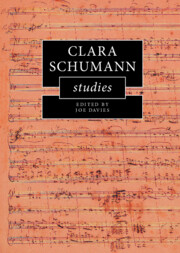Book contents
- Clara Schumann Studies
- Cambridge Composer Studies
- Clara Schumann Studies
- Copyright page
- Dedication
- Contents
- Figures
- Tables
- Music Examples
- Contributors
- Acknowledgements
- Introduction: Clara Schumann in the Musicological Imagination
- 1 Clara and Robert Schumann’s Circles in Dresden
- 2 Disillusionment and Patriotism
- 3 Softened, Smudged, Erased
- 4 A Way with Words
- 5 Clara Schumann and the Nineteenth-Century Piano Concerto
- 6 Clara Schumann and Bach
- 7 Formal Innovation and Virtuosity in Clara Schumann’s Piano Trio in G minor, Op. 17
- 8 Contextualizing Clara Schumann’s Romanzen
- 9 The Young Prophetess in Performance
- 10 Clara Schumann’s Compositional and Concertizing Strategies, and Robert Schumann’s Piano Sets
- 11 Clara: Robert’s Posthumous Androgyne
- 12 Clara Schumann, ‘Clara Schumann’ and the American Press
- 13 Clara Schumann’s Legacy As a Teacher
- Select Bibliography
- Index
3 - Softened, Smudged, Erased
Punctuation and Continuity in Clara Schumann’s Lieder
Published online by Cambridge University Press: 25 November 2021
- Clara Schumann Studies
- Cambridge Composer Studies
- Clara Schumann Studies
- Copyright page
- Dedication
- Contents
- Figures
- Tables
- Music Examples
- Contributors
- Acknowledgements
- Introduction: Clara Schumann in the Musicological Imagination
- 1 Clara and Robert Schumann’s Circles in Dresden
- 2 Disillusionment and Patriotism
- 3 Softened, Smudged, Erased
- 4 A Way with Words
- 5 Clara Schumann and the Nineteenth-Century Piano Concerto
- 6 Clara Schumann and Bach
- 7 Formal Innovation and Virtuosity in Clara Schumann’s Piano Trio in G minor, Op. 17
- 8 Contextualizing Clara Schumann’s Romanzen
- 9 The Young Prophetess in Performance
- 10 Clara Schumann’s Compositional and Concertizing Strategies, and Robert Schumann’s Piano Sets
- 11 Clara: Robert’s Posthumous Androgyne
- 12 Clara Schumann, ‘Clara Schumann’ and the American Press
- 13 Clara Schumann’s Legacy As a Teacher
- Select Bibliography
- Index
Summary
One of the most striking aspects of Clara Schumann’s songs is the way they flow. They tend to move in four-bar phrases, but each four-bar phrase is connected seamlessly with the one that follows it. One way that she creates this feeling of seamless continuity is by weakening or avoiding cadences at the ends of musical sections and the poetic stanzas associated with them, fusing together adjacent sections and stanzas by softening, smudging or even erasing the musical and poetic punctuation marks at the end of them. This chapter considers how and why she does this. Through a close analysis of two representative songs – ‘Warum willst du and’re fragen’, Op. 12 No. 11, and ‘Ich hab’ in deinem Auge’, Op. 13 No. 5 – it highlights the strategies that she uses to join together sections and stanzas, as well as the various ways that those strategies relate to the poetry. In so doing, the chapter not only reveals a crucial hallmark of Clara Schumann’s song aesthetic, but also ponders a question that has been largely neglected in recent studies of romantic form: how do musical and poetic closure relate to one another?
- Type
- Chapter
- Information
- Clara Schumann Studies , pp. 57 - 74Publisher: Cambridge University PressPrint publication year: 2021

